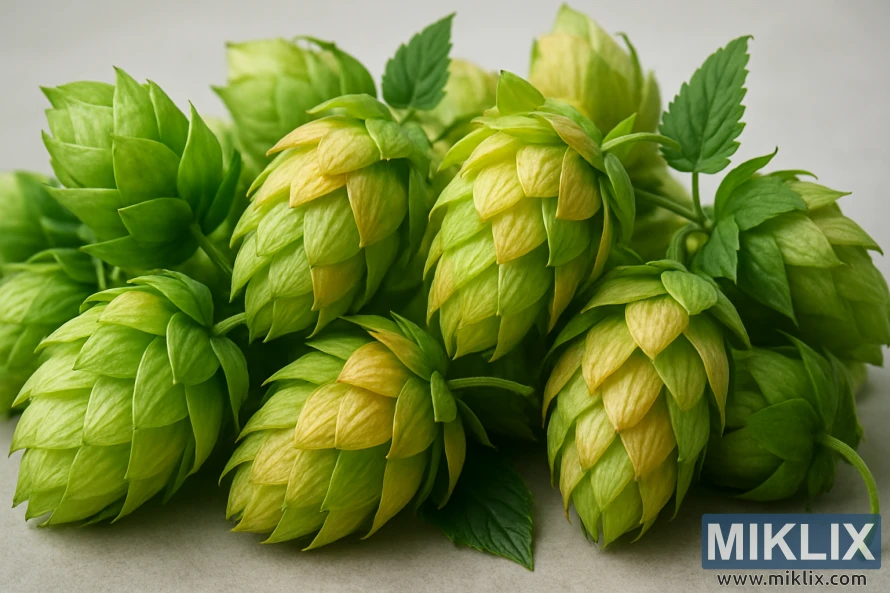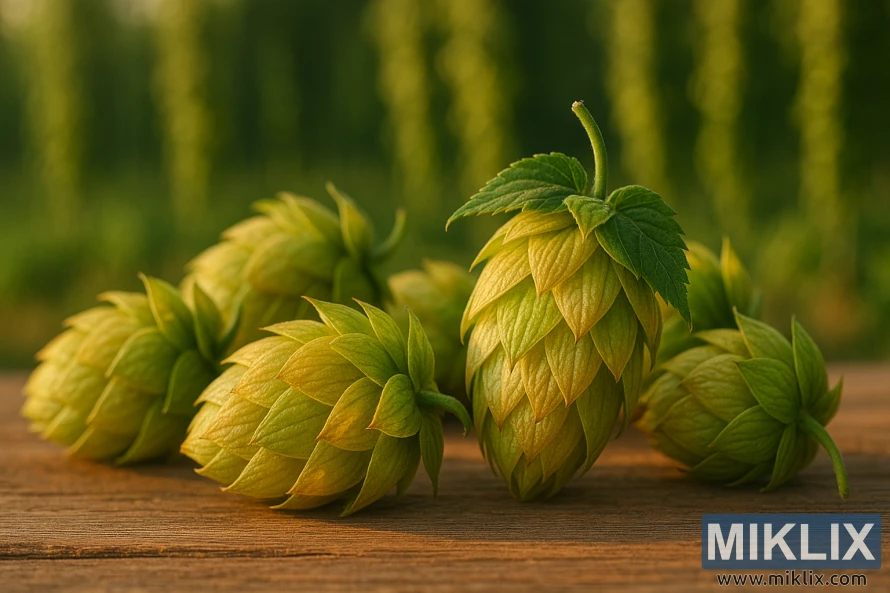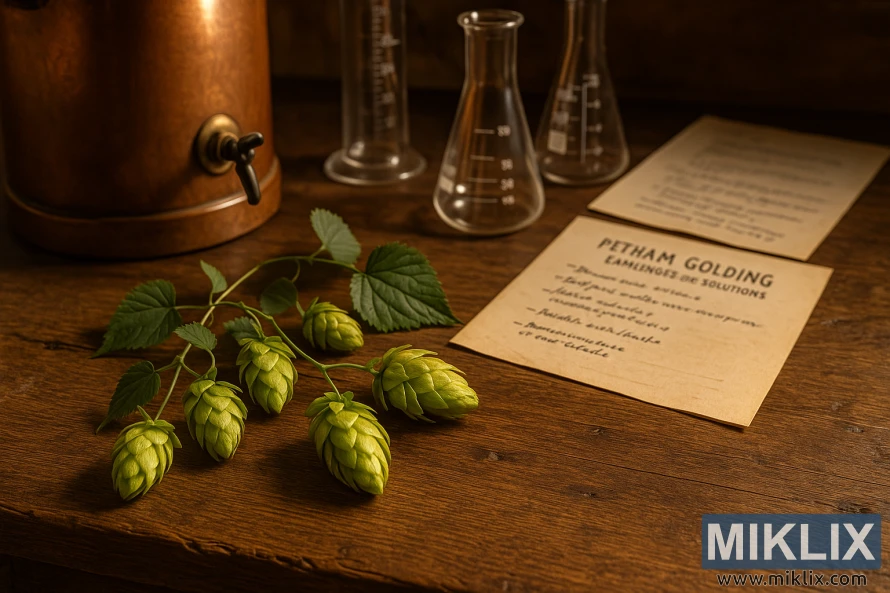Hops in Beer Brewing: Petham Golding
Published: August 10, 2025 at 11:12:34 AM UTC
Petham Golding Hops are a cherished variety among brewers, known for their distinct flavor and aroma profiles. With a rich heritage, these hops have become a staple in many breweries. They are valued for their unique characteristics that enhance the brewing process. The popularity of Petham Golding Hops among brewers can be attributed to their versatility. They add depth to various beer styles, making them a favorite choice.

Key Takeaways
- Petham Golding Hops offer unique flavor and aroma profiles.
- These hops are a staple in many breweries due to their heritage and characteristics.
- Petham Golding Hops enhance the brewing process and add depth to various beer styles.
- They are valued for their versatility in brewing.
- The use of Petham Golding Hops can elevate the quality of beer.
The Heritage of Petham Golding Hops
The history of Petham Golding hops is a rich tapestry woven into the fabric of English beer brewing. Originating in England, these hops have been a staple in the brewing industry for centuries. They have significantly contributed to the country's brewing heritage.
Golding hops, including the Petham Golding variety, have their roots deeply embedded in English soil. Their development and cultivation over the years have been influenced by traditional English farming practices. The evolving needs of brewers have also played a role. The unique characteristics of Golding hops have made them a favorite among brewers, for traditional English beer styles.
The significance of Petham Golding hops in English brewing cannot be overstated. They have been used in a variety of beer styles, imparting a distinct flavor and aroma. This is highly prized. The heritage of these hops is not just about their flavor profile. It's also about the tradition and craftsmanship they represent in the brewing process.
Over time, the cultivation of Golding hops has evolved. Advancements in agricultural practices and a deeper understanding of their brewing have been made. Despite these changes, Petham Golding hops remain true to their heritage. They continue to be a vital ingredient in many classic English beers.
The legacy of Petham Golding hops is a testament to the enduring appeal of traditional brewing methods. It highlights the importance of heritage in the brewing industry.
Understanding the Unique Properties of Petham Golding Hops
Petham Golding Hops are renowned for their sweet, honey-like flavor and delicate aroma. These hops are celebrated for their distinct flavor profile and aroma characteristics. Brewers highly value these unique properties.
The flavor of Petham Golding Hops is marked by honey notes and a subtle spiciness. This makes them a top pick for brewers aiming to add depth and complexity to their beers. Their delicate aroma also enhances various beer styles, elevating the brewing experience.
Petham Golding Hops are prized for their ability to add a rich yet refined flavor to beers. Their unique properties make them perfect for brewers crafting high-quality, distinctive beers. These beers are sure to stand out in the market.

Essential Characteristics for Brewers
Petham Golding Hops are a cornerstone in English brewing, prized for their unique blend of traits. Brewers must grasp the alpha acid content and bittering capacity of these hops. This knowledge is key to unlocking their full flavor and aroma.
These hops boast a moderate alpha acid range of 5-7%. This makes them versatile for various brewing tasks, from adding bitterness to contributing to flavor and aroma. Their balanced bittering ensures a smoothness that enhances the malt without dominating it.
The flavor profile of Petham Golding Hops is a highlight, featuring notes of spice, floral hints, and a pleasant aroma. These qualities are perfect for traditional English beer styles, such as pale ales and bitters.
- Alpha acid content: 5-7%
- Bittering capacity: Balanced, smooth bitterness
- Flavor profile: Spicy, floral
By understanding these characteristics, brewers can harness the distinct qualities of Petham Golding Hops. This allows for the creation of authentic and flavorful beers. Whether crafting a classic English ale or exploring new flavors, these hops are an essential part of any brewer's arsenal.
Best Beer Styles for Petham Golding Hops
Petham Golding Hops are versatile, fitting into a broad spectrum of beer styles. They are ideal for both traditional English ales and modern craft beers.
For centuries, Petham Golding Hops have been a cornerstone in English brewing. They are perfect for classic beer styles like:
- English Pale Ales
- Bitters
- Porters
- English-style India Pale Ales
These traditional beers gain from the earthy, floral notes of Petham Golding Hops. They enhance the malt profiles, leading to balanced, complex flavors.
But Petham Golding Hops are not limited to traditional styles. They also excel in modern brewing, allowing for the creation of innovative beers. Examples include:
- Session IPAs with a subtle hop presence
- Amber ales with a hint of spice
- Golden ales with floral notes
Modern brewers value Petham Golding Hops for their distinct flavor and aroma. These unique characteristics add depth and complexity to various beer styles.
When using Petham Golding Hops, brewers can explore different hopping techniques and combinations. This experimentation allows for the creation of unique beers that highlight the versatility of these hops.

Brewing Techniques with Petham Golding Hops
The art of brewing with Petham Golding Hops requires mastering techniques like dry hopping and late hopping. These methods unlock their full flavor and aroma.
Petham Golding Hops are celebrated for their delicate yet complex flavor profile. They are a favorite among brewers. To bring out the best in these hops, brewers employ several key techniques.
Dry hopping involves adding hops to the beer after fermentation, typically during or after conditioning. This method allows the hops to infuse their flavors and aromas into the beer without contributing bitterness. For Petham Golding Hops, dry hopping can enhance their floral and spicy notes, adding depth and complexity to the beer.
- Use a sufficient quantity of hops to achieve the desired flavor and aroma.
- Monitor the dry hopping process to avoid over-hopping, which can lead to vegetal or grassy flavors.
- Consider the beer's style and how Petham Golding Hops will complement or contrast with it.
Late hopping is another effective technique, involving adding hops towards the end of the boil. This method captures the hops' aroma and flavor while minimizing bitterness. Petham Golding Hops, with their noble heritage, are well-suited for late hopping. This technique preserves their delicate characteristics.
- Add Petham Golding Hops in the last 10-15 minutes of the boil to retain their aromatic properties.
- Adjust the quantity of hops based on the desired intensity of flavor and aroma.
- Combine late hopping with dry hopping for a layered hop profile.
By mastering these brewing techniques, brewers can fully leverage the unique qualities of Petham Golding Hops. This creates beers that are both nuanced and full of character.
Comparing Petham Golding to Other Noble Hops
The world of noble hops is rich and varied, with Petham Golding standing out for its unique traits. These hops are celebrated for their aroma and flavor, not bitterness. Petham Golding is prized for its subtle, spicy, and floral notes.
Noble hops have been essential in traditional European brewing for centuries. They are known for their low alpha acid content and distinct aromas. Petham Golding, along with Hallertau, Saaz, and East Kent Goldings, is key in crafting some of the world's most revered beers.
When comparing Petham Golding to other noble hops, several factors are considered. These include alpha acid content, aroma profile, and brewing applications. Here's a comparison of Petham Golding with some notable noble hops:
- Petham Golding: Known for its balanced alpha acid content (around 5-7%) and a complex aroma that includes earthy, floral, and slightly spicy notes.
- Hallertau: Typically has a mild aroma, with a slightly spicy and herbal character. Its alpha acid content is generally lower than Petham Golding.
- Saaz: Famous for its delicate, spicy flavor and aroma. Saaz has a very low alpha acid content, making it ideal for lagers and pilsners.
- East Kent Goldings: Offers a rich, complex aroma with notes of spice and earth. Its alpha acid content is similar to Petham Golding, making it versatile for various brewing applications.
The choice between these noble hops depends on the brewer's goals and the specific beer style being brewed. For instance, Petham Golding and East Kent Goldings are often used in ales for their rich, complex flavors. Hallertau and Saaz are commonly used in lagers for their crisp, clean characteristics.
In brewing applications, the unique characteristics of each hop variety can significantly impact the final product. Petham Golding's balanced profile makes it a versatile choice for a range of beer styles, from pale ales to bitters.
Understanding the differences between noble hops is essential for brewers aiming to craft beers with distinct flavor and aroma profiles. By comparing Petham Golding to other noble hops, brewers can make informed decisions about which varieties to use in their brewing applications.
Storage and Handling Guidelines
To keep Petham Golding Hops at their best, it's vital to adhere to specific storage and handling guidelines. These practices are key to preserving the hops' unique traits and flavor. Proper care ensures the hops' quality remains intact.
When storing Petham Golding Hops, brewers should consider several factors:
- Temperature: Store hops in a cool, consistent refrigerated environment, ideally between 32°F and 40°F (0°C and 4°C).
- Humidity: Maintain a low humidity level to prevent moisture from affecting the hops. Aim for a relative humidity of 50% or lower.
- Light: Protect hops from direct light, as it can cause degradation of the alpha acids and essential oils.
- Oxygen: Minimize exposure to oxygen by using airtight containers or packaging that prevents air from reaching the hops.
Handling Petham Golding Hops requires care to prevent damage and preserve their quality. Here are some best practices:
- Handle hop packages gently to avoid damaging the contents.
- Use clean equipment and utensils when handling hops to prevent contamination.
- Minimize the time hops are exposed to air during the brewing process.
By following these storage and handling guidelines, brewers can ensure that their Petham Golding Hops remain in optimal condition. This readiness is essential for creating high-quality beers.
Common Brewing Challenges and Solutions
Brewing with Petham Golding Hops can present several challenges. One major concern is achieving the right flavor profile. Petham Golding Hops have a distinct character that can be tricky to balance.
Several factors can lead to brewing challenges with Petham Golding Hops. These include the hop's alpha acid content, storage conditions, and brewing techniques. For example, Petham Golding Hops have a lower alpha acid content than many other hops. This can impact bitterness levels and overall flavor.
To overcome these challenges, brewers can use several strategies. It's vital to understand the unique properties of Petham Golding Hops. This knowledge helps brewers make informed decisions about hop quantities, brewing times, and techniques.
Some common solutions to brewing challenges with Petham Golding Hops include:
- Adjusting hop quantities to achieve the desired flavor profile
- Optimizing brewing techniques, such as hop addition times and temperatures
- Monitoring storage conditions to preserve hop quality
- Experimenting with different brewing styles to complement the characteristics of Petham Golding Hops
By understanding the challenges and implementing effective solutions, brewers can unlock the full flavor of Petham Golding Hops. This allows them to create high-quality beers that showcase the hop's unique flavor and aroma.

Commercial Brewing Applications
Petham Golding Hops have become essential in commercial brewing for their consistent quality and unique flavor. They are highly valued in large-scale brewing for their ability to provide a traditional flavor consistently. This reliability is key for brewers aiming for quality in their products.
In commercial brewing, Petham Golding Hops are used across various beer styles, from classic ales to complex lagers. Their versatility makes them a top choice for brewers aiming to create a range of beers with a consistent hop character. This consistency is vital for maintaining quality across different brews.
The advantages of using Petham Golding Hops include their consistent alpha acid content. This ensures predictable bitterness levels in the beer. Their complex flavor profile also adds depth to different beer styles, enriching the overall taste experience.
In summary, Petham Golding Hops are a reliable and versatile option for commercial breweries. They offer a range of brewing applications and consistent quality, making them a preferred choice for brewers.
Recipe Development Strategies
Petham Golding Hops provide brewers with a versatile tool for crafting unique beer recipes. By grasping the characteristics of these hops, brewers can create innovative beers that capture attention in the market.
To craft compelling beer recipes, brewers should employ several strategies:
- Experiment with different hop combinations to find the perfect balance for your beer.
- Adjust the quantity of Petham Golding Hops based on the desired intensity of flavor and aroma.
- Pair Petham Golding Hops with complementary ingredients to enhance the beer's overall character.
When developing beer recipes, it's vital to consider the brewing techniques that will best showcase the qualities of Petham Golding Hops. Techniques such as dry-hopping or late-hopping can significantly impact the final flavor and aroma of the beer.
Brewers can also experiment with different beer styles to find the best match for Petham Golding Hops. Whether it's a traditional ale or a modern IPA, the key is to balance the hop flavor with other ingredients.
By embracing these recipe development strategies, brewers can unlock the full flavor of Petham Golding Hops. This allows them to create beers that delight the palate.
Quality Assessment and Selection
To achieve the best flavor, evaluating the quality of Petham Golding Hops is essential. The quality of these hops significantly impacts the final product. Brewers must assess and select the best hops for their brewing needs.
When evaluating Petham Golding Hops, brewers should focus on several key factors. These include the hop's aroma, appearance, and alpha acid content. High-quality hops should have a pleasant, floral aroma and a robust appearance.
The selection process involves evaluating the hops based on these criteria. Brewers should choose those that best suit their specific needs. Here are some key considerations:
- Aroma: Petham Golding Hops are known for their floral and slightly spicy aroma.
- Alpha Acid Content: The alpha acid content affects the bitterness of the beer.
- Appearance: High-quality hops should have a robust appearance with minimal signs of deterioration.
By carefully assessing and selecting Petham Golding Hops, brewers can ensure their beer has the desired flavor and quality. This attention to detail is what sets exceptional brews apart from the rest.
Seasonal Considerations and Availability
The seasonal availability of Petham Golding Hops is critical for brewing schedules. Harvested in late summer to early fall, this traditional English hop variety's timing affects the brewing industry. Breweries that depend on a steady supply of quality hops face challenges.
To navigate these challenges, brewers must plan their hop purchases and brewing schedules with care. They often place orders well in advance to secure their hop supplies. Key factors include:
- Harvest timing and its impact on hop quality
- Storage conditions to preserve hop quality
- Flexibility in brewing schedules to accommodate seasonal hop availability
Understanding these seasonal factors helps brewers manage their hop inventory and schedules effectively. With proper planning, breweries can maintain a consistent supply of Petham Golding Hops. This ensures they can meet consumer demand and maintain production levels.
Conclusion
Mastering Petham Golding Hops is a journey that demands a deep understanding of their unique properties. By incorporating these versatile hops into your brewing, you can craft complex and nuanced beers. These beers will showcase your brewery's best practices.
Petham Golding Hops bring a distinct flavor and aroma to a variety of beer styles. To achieve the best results, following proper storage and handling guidelines is essential. Staying informed about seasonal considerations and availability is also key.
The future of brewing with Petham Golding Hops is vast and exciting. By experimenting with different brewing techniques and recipe development strategies, you can unlock new and exciting flavor profiles. Whether you're a seasoned brewer or just starting out, mastering Petham Golding Hops is a key step. It will take your brewing to the next level and shape the future of brewing.
Further Reading
If you enjoyed this post, you may also like these suggestions:
